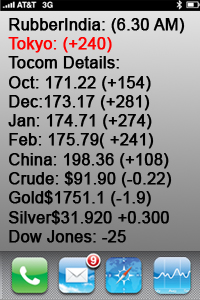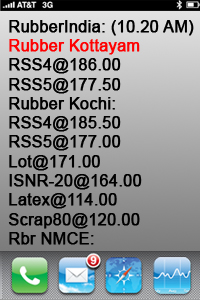
October 31, 2023
Rubber India
Overview
Today, Japanese rubber futures experienced a decline due to weak demand from China. However, they are still on track for monthly gains, supported by a weaker yen.
Market Highlights
Japanese Rubber Futures:
The Osaka Exchange (OSE) rubber contract for April delivery fell by 1.4 yen, or 0.45%, to 312 yen ($2.07) per kg.
Despite this drop, the contract has risen by 2.06% so far this month.
Shanghai Futures Exchange (SHFE):
The rubber contract for January delivery decreased by 400 yuan, or 2.58%, to 15,095 yuan ($2,119.19) per metric ton.
The December butadiene rubber contract also fell, losing 165 yuan, or 1.53%, to 10,605 yuan per metric ton.
Singapore Exchange (SICOM):
The front-month rubber contract for November delivery last traded at 174 U.S. cents per kg, down 0.4%.
Factors Influencing the Market
Demand from China:
China’s factory activity has shrunk for the seventh consecutive month, indicating weak domestic demand in the second largest economy.
Currency Impact:
The U.S. dollar strengthened 0.9% against the yen, reaching 154.08, the highest level since February. A weaker yen makes yen-denominated assets more affordable for international buyers.
Oil Prices:
Oil prices have eased due to a stronger dollar and rising supply from major producers. Natural rubber prices often follow oil trends as it competes with synthetic rubber derived from crude oil.
Production Conditions:
Major producing regions are moving into peak production season, and better weather conditions are expected to enhance raw material supply, which could further suppress rubber prices.
Automotive Industry:
The ongoing Nexperia chip crisis is causing challenges for automakers, which may affect rubber demand as automobile manufacturing relies heavily on rubber-made tires.
Economic Context
The U.S. Federal Reserve cut interest rates by 0.25% to a range of 3.75–4.00%. Fed Chair Jerome Powell indicated that there are no clear plans for further rate cuts, which adds a layer of uncertainty to the market.
President Trump announced a reduction in import tariffs on Chinese goods, but the lack of an official statement from China has left investors cautious about potential trade issues.
Conclusion
The natural rubber market is showing signs of resilience despite current challenges, primarily driven by a weaker yen and anticipated increases in supply. However, ongoing economic uncertainties and weak demand from China could impact future prices.



